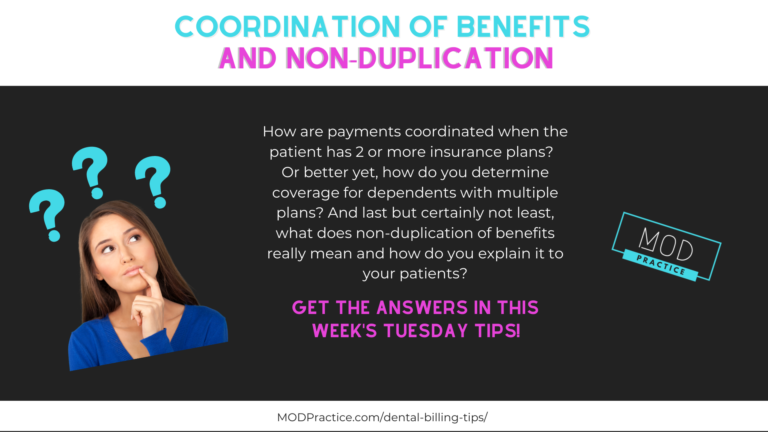Today we’re chatting about one of the more confusing aspects of dental billing: coordination of benefits surrounding patients with primary and secondary coverage where the secondary plan is non-duplication.
What is coordination of benefits or COB?
COB, short for coordination of benefits, is when the patient is covered by more than one benefit plan (dual coverage) and the two benefit plans are coordinated so that no more than 100 percent of the total covered expense of any treatment is paid. For example, the patient has coverage with their employer’s plan and their spouse may have also elected dependent dental coverage for you under his or her employer’s plan. With dual coverage, the respective carriers must coordinate benefits paid so that benefits do not exceed the total cost of the treatment.
How does dual coverage work?
Dual coverage doesn’t necessarily mean that your patient’s benefits are doubled. Dual coverage works the same way whether the patient is covered by the same insurance carrier (Cigna/Cigna) or by different insurance carriers (Cigna/Metlife). One insurance simply works with the other insurance to coordinate benefits paid.
Here are a few examples:
- Family has dual coverage. Who pays first? Who pays second? One plan is identified as the primary carrier, the plan that pays first, and the other is identified as the secondary carrier, the one that pays second. Generally, the primary carrier is the plan that covers the patient as a primary enrollee (the patient’s employer’s plan rather than the spouse’s employer’s plan).
- If the patient is the primary enrollee for both plans, the plan that has covered you longer is considered primary. There are variances (for laid off and retired employees, for example).
- For dependent children’s coverage, the primary carrier is generally determined by the birthday rule: The benefit plan of the parent whose birthday (month and day, not year) comes first in the year is considered to be your children’s primary coverage. The birthday rule may be superseded by a divorce agreement or other court ruling. For example, if the father’s birthday is March 22 and the mother’s birthday is March 5, the mother’s plan is identified as the primary carrier and the father’s plan is identified as the secondary carrier. If both parents have the same birthday, then the plan that has been effective for a longer period of time will be the primary plan. For example, if the father has been covered under his plan for 10 years and the mother has been covered under her plan for two years, the father’s would be the primary plan and the mother’s would be the secondary plan. If the parents are separated or divorced, and two or more plans cover the same child as a dependent, the order of benefit determination is as follows (unless a court decree states differently; please see your certificate of coverage or benefits booklet for specific details):
1. The plan of the parent with custody of the child
2. The plan of the spouse of the parent with custody of the child
3. The plan of the parent not having custody of the child
What is a “ Carve out clause” or non duplication of benefits plan?
A “carve out clause” is a contractual term more commonly known as a non-duplication of benefits. There is standard coordination of benefits and there is non-duplication of benefits which is the focus of our Tuesday Tip. Non-duplication of benefits defines how secondary insurance pays after the primary has paid their portion of the claim. Have you ever seen the remark: “payment has been reduced by primary carriers payment and exceeds the allowable amount”? This remark indicates that the secondary plan is non-duplication and that the primary payment is equal or greater than what the secondary would have paid. In this scenario, the secondary will not make any additional payments towards the claim as the primary has paid in full. If the both plans are in-network, any additional balance on the ledger must be written off as an adjustment. If the primary plan pays under UCR fees and the secondary is in-network, you are not required to adjust the ledger to your in-network fee. You would adjust the balance to reflect the remaining patient portion on the secondary.
Why not twice as many benefits?
Dual coverage limitations, like all other program limitations, are built into a group’s contract and into the rates a group pays for your coverage. These contracts are set up to provide affordable dental care to a maximum number of people. Given the choice between doubling one individual’s benefits or providing a greater scope of benefits to more people in the group, most group purchasers choose to spread their benefit dollars more evenly
Still have questions about coordinations of benefits and non-duplication plans? Feel free to reach out!
Interested in learning more about Revenue Cycle Management for your practice? Contact us today!

